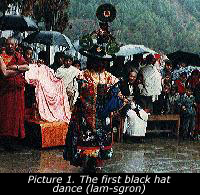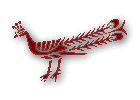|
 The Tenth Day 'Chams.
The Guru mTshan brgyad 'chams in Rewalsar is performed in the
context of an intensive practice session of MahAyoga ritual. From
the monks' perspective, the public dance represents a culmination of
several days of meditation and mantra recitation. MahAyoga is one of
the ''Inner Tantras'' in the rNying-ma-pa classification system, in
which visual imagery is relied upon. From the time of empowerment,
the practitioner should experience himself and other beings as
manifestations of the enlightened deity form, and all phenomena as
the attributes of the divine palace and maNDala (transformed circle
of the universe). In 1982, the specific practice performed was that
of the bDud-'joms Bla-sgrub, a practice designed to ''accomplish the
heart/mind (thugs) of the lama'', in this case, in the form of Guru
Padma. The main visualisation is that of the maNDala of HayagrIva
with consort, surrounded by DAkinI emanations, together with male
'ging', beyond which there is an outer circle of numerous other
deities. Above HayagrIva arises the central form of Guru Padma,
encircled by his Thod-phreng-rtsal emanations in the four cardinal
directions, each one associated with one of the ''Buddha
families'',29 and beyond these, his eight aspects (mtshan brgyad) arise above the eight points of the compass. The Tenth Day 'Chams.
The Guru mTshan brgyad 'chams in Rewalsar is performed in the
context of an intensive practice session of MahAyoga ritual. From
the monks' perspective, the public dance represents a culmination of
several days of meditation and mantra recitation. MahAyoga is one of
the ''Inner Tantras'' in the rNying-ma-pa classification system, in
which visual imagery is relied upon. From the time of empowerment,
the practitioner should experience himself and other beings as
manifestations of the enlightened deity form, and all phenomena as
the attributes of the divine palace and maNDala (transformed circle
of the universe). In 1982, the specific practice performed was that
of the bDud-'joms Bla-sgrub, a practice designed to ''accomplish the
heart/mind (thugs) of the lama'', in this case, in the form of Guru
Padma. The main visualisation is that of the maNDala of HayagrIva
with consort, surrounded by DAkinI emanations, together with male
'ging', beyond which there is an outer circle of numerous other
deities. Above HayagrIva arises the central form of Guru Padma,
encircled by his Thod-phreng-rtsal emanations in the four cardinal
directions, each one associated with one of the ''Buddha
families'',29 and beyond these, his eight aspects (mtshan brgyad) arise above the eight points of the compass.  After the completion of
the Generation and Invitation to the maNDala deities, together with
ritual activities such as making offerings and reciting praises to
them, the main practice through which the practitioner fully
realises his identity with the lama, is performed. In the first
stage (the ''Approach''), the practitioner identifies with
HayagrIva, and reciting the mantra of Guru Padma, he imagines the
Guru/lama upon his head. Then he receives empowerment through light
rays from the Guru dissolving into himself. Finally, Guru Padma and
his retinue arise within his/HayagrIva's heart, and within the
Guru's heart, the seed-syllable, surrounded by the syllables of the
mantra, radiate light, purifying and transforming all beings into
the lama. With the understanding that the nature of one's own mind
is inseparable from that of the lama, and that all appearances are
nothing other than his form, all sounds are his mantra, and all
thoughts his mind, the Thod-phreng-rtsal mantra is recited and the
''Accomplishment'' stage effected. A further meditation on
accomplishing enlightened activities completes the main practice. After the completion of
the Generation and Invitation to the maNDala deities, together with
ritual activities such as making offerings and reciting praises to
them, the main practice through which the practitioner fully
realises his identity with the lama, is performed. In the first
stage (the ''Approach''), the practitioner identifies with
HayagrIva, and reciting the mantra of Guru Padma, he imagines the
Guru/lama upon his head. Then he receives empowerment through light
rays from the Guru dissolving into himself. Finally, Guru Padma and
his retinue arise within his/HayagrIva's heart, and within the
Guru's heart, the seed-syllable, surrounded by the syllables of the
mantra, radiate light, purifying and transforming all beings into
the lama. With the understanding that the nature of one's own mind
is inseparable from that of the lama, and that all appearances are
nothing other than his form, all sounds are his mantra, and all
thoughts his mind, the Thod-phreng-rtsal mantra is recited and the
''Accomplishment'' stage effected. A further meditation on
accomplishing enlightened activities completes the main practice.
[This is a preview of the full page; if you are a member of the Asiatica Association and have access to the IJTS,
please login using the box on the left menu; non members: please become a member to support the Asiatica Association, and get full access to our publications.]
|

 The Tenth Day 'Chams.
The Guru mTshan brgyad 'chams in Rewalsar is performed in the
context of an intensive practice session of MahAyoga ritual. From
the monks' perspective, the public dance represents a culmination of
several days of meditation and mantra recitation. MahAyoga is one of
the ''Inner Tantras'' in the rNying-ma-pa classification system, in
which visual imagery is relied upon. From the time of empowerment,
the practitioner should experience himself and other beings as
manifestations of the enlightened deity form, and all phenomena as
the attributes of the divine palace and maNDala (transformed circle
of the universe). In 1982, the specific practice performed was that
of the bDud-'joms Bla-sgrub, a practice designed to ''accomplish the
heart/mind (thugs) of the lama'', in this case, in the form of Guru
Padma. The main visualisation is that of the maNDala of HayagrIva
with consort, surrounded by DAkinI emanations, together with male
'ging', beyond which there is an outer circle of numerous other
deities. Above HayagrIva arises the central form of Guru Padma,
encircled by his Thod-phreng-rtsal emanations in the four cardinal
directions, each one associated with one of the ''Buddha
families'',
The Tenth Day 'Chams.
The Guru mTshan brgyad 'chams in Rewalsar is performed in the
context of an intensive practice session of MahAyoga ritual. From
the monks' perspective, the public dance represents a culmination of
several days of meditation and mantra recitation. MahAyoga is one of
the ''Inner Tantras'' in the rNying-ma-pa classification system, in
which visual imagery is relied upon. From the time of empowerment,
the practitioner should experience himself and other beings as
manifestations of the enlightened deity form, and all phenomena as
the attributes of the divine palace and maNDala (transformed circle
of the universe). In 1982, the specific practice performed was that
of the bDud-'joms Bla-sgrub, a practice designed to ''accomplish the
heart/mind (thugs) of the lama'', in this case, in the form of Guru
Padma. The main visualisation is that of the maNDala of HayagrIva
with consort, surrounded by DAkinI emanations, together with male
'ging', beyond which there is an outer circle of numerous other
deities. Above HayagrIva arises the central form of Guru Padma,
encircled by his Thod-phreng-rtsal emanations in the four cardinal
directions, each one associated with one of the ''Buddha
families'', After the completion of
the Generation and Invitation to the maNDala deities, together with
ritual activities such as making offerings and reciting praises to
them, the main practice through which the practitioner fully
realises his identity with the lama, is performed. In the first
stage (the ''Approach''), the practitioner identifies with
HayagrIva, and reciting the mantra of Guru Padma, he imagines the
Guru/lama upon his head. Then he receives empowerment through light
rays from the Guru dissolving into himself. Finally, Guru Padma and
his retinue arise within his/HayagrIva's heart, and within the
Guru's heart, the seed-syllable, surrounded by the syllables of the
mantra, radiate light, purifying and transforming all beings into
the lama. With the understanding that the nature of one's own mind
is inseparable from that of the lama, and that all appearances are
nothing other than his form, all sounds are his mantra, and all
thoughts his mind, the Thod-phreng-rtsal mantra is recited and the
''Accomplishment'' stage effected. A further meditation on
accomplishing enlightened activities completes the main practice.
After the completion of
the Generation and Invitation to the maNDala deities, together with
ritual activities such as making offerings and reciting praises to
them, the main practice through which the practitioner fully
realises his identity with the lama, is performed. In the first
stage (the ''Approach''), the practitioner identifies with
HayagrIva, and reciting the mantra of Guru Padma, he imagines the
Guru/lama upon his head. Then he receives empowerment through light
rays from the Guru dissolving into himself. Finally, Guru Padma and
his retinue arise within his/HayagrIva's heart, and within the
Guru's heart, the seed-syllable, surrounded by the syllables of the
mantra, radiate light, purifying and transforming all beings into
the lama. With the understanding that the nature of one's own mind
is inseparable from that of the lama, and that all appearances are
nothing other than his form, all sounds are his mantra, and all
thoughts his mind, the Thod-phreng-rtsal mantra is recited and the
''Accomplishment'' stage effected. A further meditation on
accomplishing enlightened activities completes the main practice.